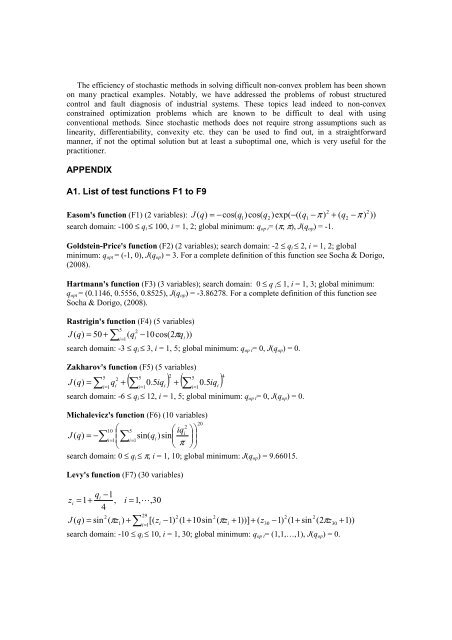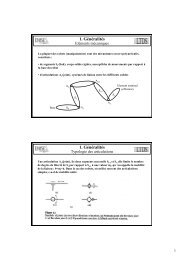q - Rosario Toscano - Free
q - Rosario Toscano - Free
q - Rosario Toscano - Free
Create successful ePaper yourself
Turn your PDF publications into a flip-book with our unique Google optimized e-Paper software.
The efficiency of stochastic methods in solving difficult non-convex problem has been shown<br />
on many practical examples. Notably, we have addressed the problems of robust structured<br />
control and fault diagnosis of industrial systems. These topics lead indeed to non-convex<br />
constrained optimization problems which are known to be difficult to deal with using<br />
conventional methods. Since stochastic methods does not require strong assumptions such as<br />
linearity, differentiability, convexity etc. they can be used to find out, in a straightforward<br />
manner, if not the optimal solution but at least a suboptimal one, which is very useful for the<br />
practitioner.<br />
APPENDIX<br />
A1. List of test functions F1 to F9<br />
2<br />
2<br />
Easom's function (F1) (2 variables): J ( q)<br />
= −cos(<br />
q1)<br />
cos( q2)<br />
exp( −((<br />
q1<br />
− π ) + ( q2<br />
− π ) ))<br />
search domain: -100 ≤ qi ≤ 100, i = 1, 2; global minimum: qop t= (π, π), J(qop) = -1.<br />
Goldstein-Price's function (F2) (2 variables); search domain: -2 ≤ qi ≤ 2, i = 1, 2; global<br />
minimum: qopt = (-1, 0), J(qop) = 3. For a complete definition of this function see Socha & Dorigo,<br />
(2008).<br />
Hartmann's function (F3) (3 variables); search domain: 0 ≤ q i≤ 1, i = 1, 3; global minimum:<br />
qopt = (0.1146, 0.5556, 0.8525), J(qop) = -3.86278. For a complete definition of this function see<br />
Socha & Dorigo, (2008).<br />
Rastrigin's function (F4) (5 variables)<br />
5<br />
∑ i=<br />
1<br />
2<br />
J ( q)<br />
= 50 + ( q −10<br />
cos( 2π<br />
q ))<br />
i<br />
search domain: -3 ≤ qi ≤ 3, i = 1, 5; global minimum: qop t= 0, J(qop) = 0.<br />
i<br />
Zakharov's function (F5) (5 variables)<br />
( ) ( ) 4<br />
5<br />
2<br />
2 5<br />
5<br />
J ( q)<br />
= ∑ q + 0.<br />
5 0.<br />
5<br />
= 1 ∑ +<br />
i i iq<br />
i=<br />
1 i ∑ iq<br />
i=<br />
1 i<br />
search domain: -6 ≤ qi ≤ 12, i = 1, 5; global minimum: qop t= 0, J(qop) = 0.<br />
Michalevicz's function (F6) (10 variables)<br />
∑ = ∑ = ⎟ 2<br />
10 ⎛ 5 ⎛ iq ⎞⎞<br />
⎜<br />
i<br />
J ( q)<br />
= −<br />
⎜<br />
sin( q ) sin ⎜<br />
⎟<br />
i 1 i 1 i<br />
⎝<br />
⎝ π ⎠⎠<br />
search domain: 0 ≤ qi ≤ π, i = 1, 10; global minimum: J(qop) = 9.66015.<br />
Levy's function (F7) (30 variables)<br />
qi<br />
−1<br />
zi<br />
= 1+ , i = 1,<br />
L,<br />
30<br />
4<br />
29<br />
= 1 ∑ i=<br />
1<br />
20<br />
2<br />
2<br />
2<br />
2 2<br />
J ( q)<br />
sin ( π z ) + [( zi<br />
−1)<br />
( 1+<br />
10sin<br />
( πzi<br />
+ 1))]<br />
+ ( z30<br />
−1)<br />
( 1+<br />
sin ( 2πz30<br />
+ 1))<br />
search domain: -10 ≤ qi ≤ 10, i = 1, 30; global minimum: qop t= (1,1,…,1), J(qop) = 0.



